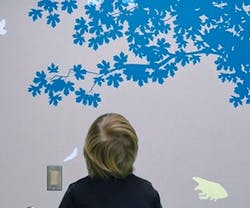Playful Environments
In our work at Potion, we strive to bring together technology, design, and art to create emotional, interactive experiences. For the last two years, we’ve collaborated with the Ohio State University’s new Wexner Medical Center James Cancer Hospital and Solove Research Institute (“the James”), to create a playful and fun experience for patients and their families, and an environment that helps doctors and nurses concentrate on the serious work of curing cancer.
The James is a top academic medical center that prides itself on using innovation to drive research, education, and clinical care. When patients experience “positive distraction” during their course of treatment—for example, viewing natural environments from their bedside—attention is diverted away from the discomfort of their care. As a result, they feel less stressed, which in turn allows their caregivers to spend more of their energy administering the course of treatment. There is a growing body of research that shows implementing “positive distraction” in patient environments may lead to better patient care by caregivers, which results in improvement in patient outcomes.
The James and its architectural team HOK challenged Potion to produce a setting that could employ this theory for their youngest, most vulnerable cancer patients. Radiation oncology treatment is a process that may last anywhere from one to five weeks and causes significant physical discomfort. We asked ourselves: How can we generate an interior design intervention that could help patients aged three to 18 endure a treatment that would help save their lives?
Potion embarked on an extensive research and discovery phase in which the team shadowed the hospital staff during daily operations. The goal was to fully grasp both the operational challenges of a hospital environment, and a child’s experience of radiation oncology treatment. Potion conducted interviews with key staff members, recorded patient dwell times, and observed workflows through the hospital. The information was distilled into personas and we used cases to describe how patients, parents, and staff encounter each step of their treatment. We also consulted extensively with OSU’s collaborators at Nationwide Children’s Hospital, who achieved success with their environmental Magic Forest characters and graphics program developed by Ralph Appelbaum Associates.
Utilizing this research, we defined what the interactive experience should be and grounded our concept with these guiding principles:
- Empowering: Give patients ownership of their treatment journey.
- Familiar: Create an environment that is welcoming and friendly.
- Dependable: Build trust between patients and the institution.
- Shared experience: Unite patients, their families, and staff.
From these principles, we created Forest Friends, a magical environment of interactive interventions that support a patient during three stressful waypoints on their journey: the Pediatric Waiting Room, the Exam Room, and the Anesthesia Induction Room.
In the Pediatric Waiting Room, patients are empowered to choose an animal companion (by selecting a fun, colored bracelet) to join them for the day. Scanning the bracelet brings one of the Nationwide Children’s Hospital characters to life—for example, a pink bunny who hops onto the screen and waves to greet you. You can ask her to follow you to the Exam Room or elsewhere, and she interacts with the magical environment and other creatures in fun and unexpected ways. The bunny models patient behavior, being playful when there is time for distraction—for example, when wait times for treatment time are long, or when waiting for a doctor to enter an exam room. Parents and staff can trigger certain reactions from the Forest Friend, like sitting quietly and listening, or waving goodbye and beckoning patients to follow, which all help ease a child’s transition from one space to another. In the Anesthesia Induction Room, an animal companion simply yawns, drifts to sleep, and dreams big dreams, giving the young patient a scene to focus on while falling asleep.
Each environment is designed to be interactive on two levels. The first is simply engaging and playing with a Forest Friend, an experience designed for younger patients. And second, the environment itself can change. Older patients can take control of the forest itself by planting trees in the waiting room or changing the color of the exam room. Because patients return for treatment daily, sometimes for weeks, the environment itself is generative and transforms every day, presenting new vegetation, background colors, and environments both familiar and new. We wanted to provide a dependable experience that patients could count on during their treatment and have something to look forward to.
By building experiences for different personas—a 5-year-old in treatment, the mother of the patient, a 15-year-old sibling, and a staff member—we discovered that positive patient distraction would allow parents to feel less stressed, and staff to perform their jobs more effectively. In addition, it is our ambition to make children feel calmer as they enter treatment, which can result in a reduced need for anesthesia during treatment. Less anesthesia means less risk, and best of all, less risk means better patient outcomes.
Since launching in early 2015, Forest Friends has become integral to the activities of the Wexner Medical Center, most importantly in its connection with ‘the bell.’ Traditionally, when patients finished a course of treatment, they would ring a bell that resounds in celebration. Potion built upon this tradition with Forest Friends by designing an interactive bell, that when rung causes a ripple effect of celebration across all animal friends and their environments.
To create Forest Friends, Potion deployed our experience with museum and institutional environments in a new setting, healthcare—where the effects of interactive technologies not only delight our users, but have transformative effects on what matters most: our health.
Phillip Tiogson is the principal and Holly Houghton is a producer at Potion Design, a studio that crafts technology into intuitive, interactive experiences.
